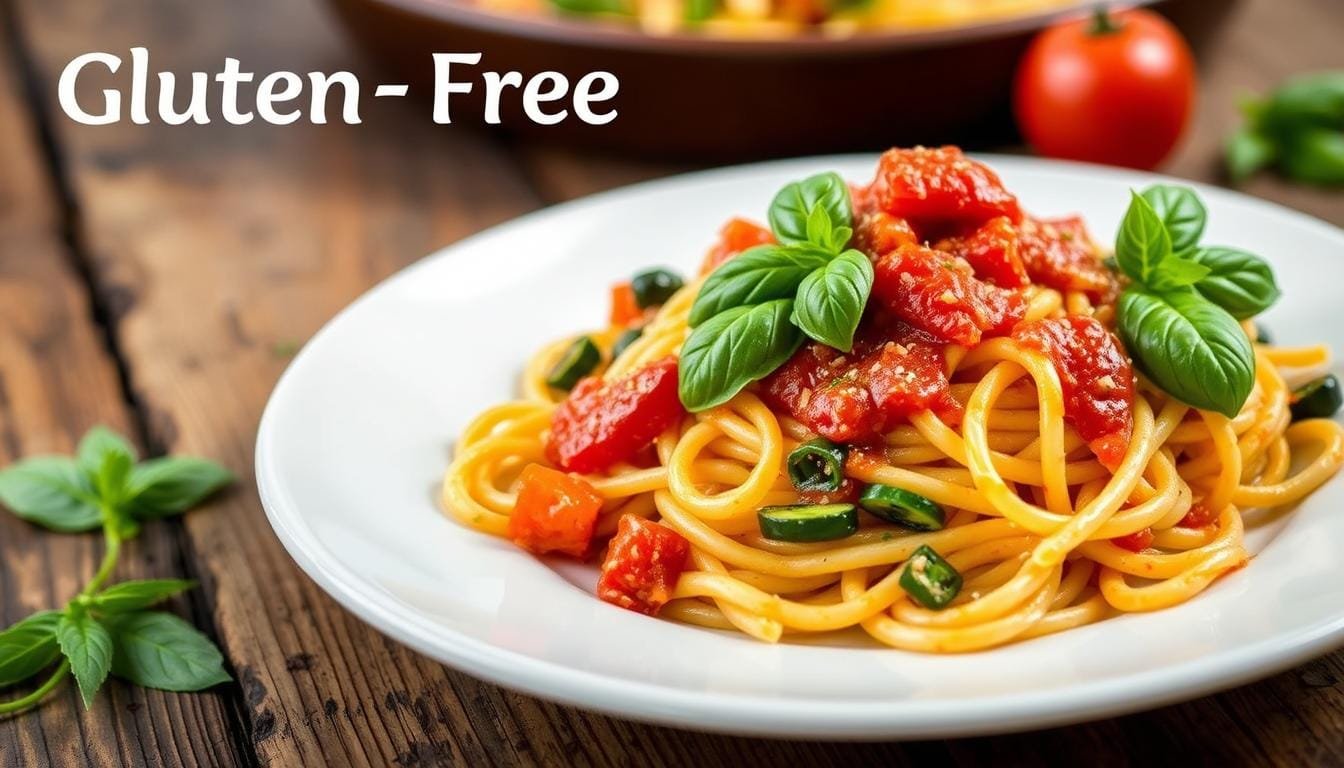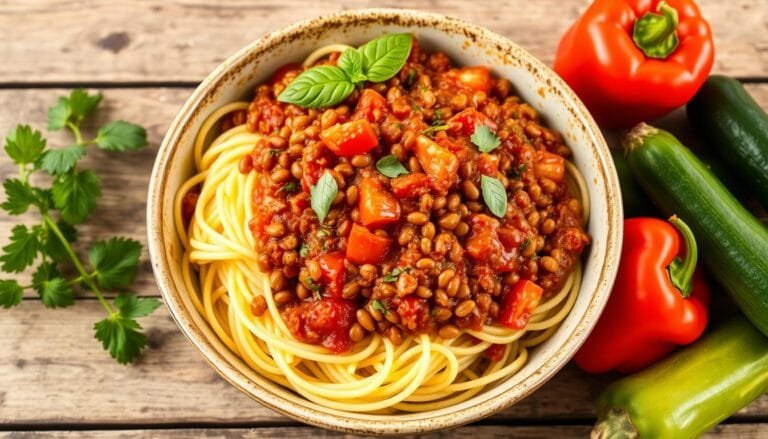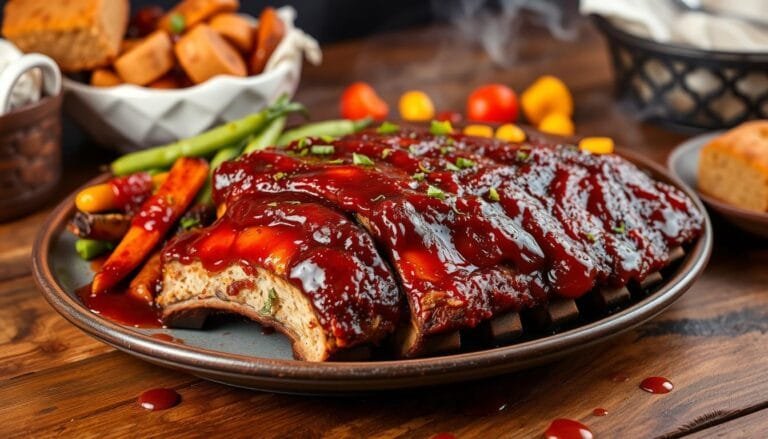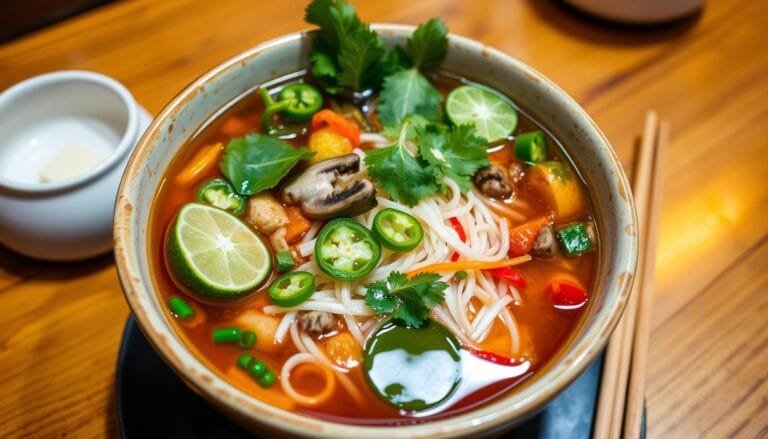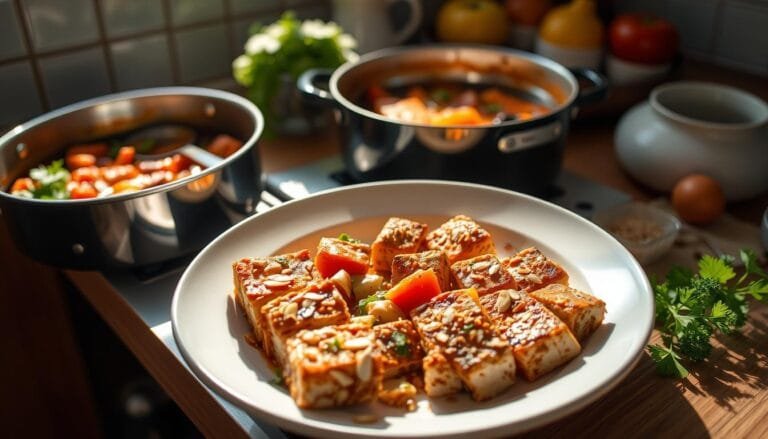I love cooking at home, and pasta is a favorite, even on a gluten-free diet. I make pasta at least once a week to get that comforting taste. I’m excited to share a simple recipe for vegan gluten-free pasta that’s tasty and healthy.
This recipe is a big deal. It uses simple ingredients to make a smooth dough. You can make many pasta shapes with it, like spaghetti, linguine, or rigatoni. It’s eggless and gluten-free, so you can enjoy it without feeling guilty.
Why Make Your Own Vegan Pasta at Home
Making your own vegan pasta at home has many benefits. It’s healthier, more cost-effective, and lets you control what goes into it. These reasons make it a great choice for making your own gluten-free pasta.
Health Benefits of Homemade Pasta
When you make pasta at home, you choose the ingredients. This means you can avoid eggs and other animal products. Your pasta can be ready in just 1-2 minutes and lasts up to a month.
Homemade pasta sauces also tend to have less salt and sugar. This makes your meals healthier and more balanced.
Cost-Effectiveness Compared to Store-Bought Options
Homemade pasta is cheaper than buying it. The ingredients like flour, water, and herbs are affordable. This way, you can make a lot of pasta for less money than store-bought.
Control Over Ingredients and Quality
With homemade pasta, you control what goes into it. You can avoid preservatives and artificial additives found in store-bought pasta. You can also try different flours, like gluten-free ones, to meet your dietary needs.
Homemade pasta-making is a rewarding hobby. It improves your health, saves money, and lets you create something special. It’s a journey worth taking, whether you’re experienced or new to cooking.
Essential Ingredients for Perfect Pasta Dough
Making delicious vegan gluten-free pasta at home needs a few key ingredients. The dough starts with a mix of flours like all-purpose, einkorn, 00, or gluten-free 1:1 baking flour. These flours give the pasta its structure and texture.
Sea salt adds flavor, and olive oil brings a rich, savory taste. For those without eggs, water or dairy-free yogurt can be used as binders. If you’re looking for a gluten-free option, einkorn flour has a unique nutty flavor. Semolina flour is great if you don’t need gluten-free, as it gives pasta its classic texture.
| Ingredient | Purpose |
|---|---|
| Gluten-free 1:1 Baking Flour | Provides structure and texture |
| Einkorn Flour | Low-gluten alternative with nutty flavor |
| Semolina Flour | Enhances traditional pasta texture (for non-gluten-free recipes) |
| Sea Salt | Essential seasoning |
| Olive Oil | Adds richness and savory notes |
| Water or Dairy-Free Yogurt | Egg replacements for vegan binding |
With these vegan pasta ingredients, gluten-free flour options, and egg replacements for pasta, you’re ready to make homemade pasta.
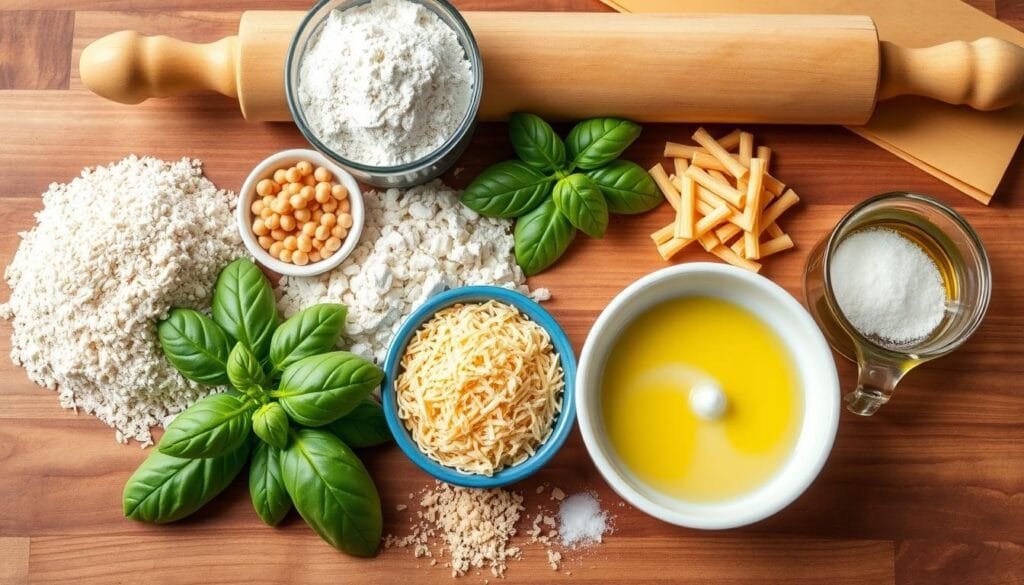
Two Methods to Make Homemade Vegan Gluten-Free Pasta
Making vegan pasta at home is easier than you think. There are two simple methods: the water-based and the dairy-free yogurt way. Both let you enjoy homemade vegan pasta that’s also gluten-free.
Water-Based Method
The water-based method needs just a few things: flour, water, olive oil, and salt. It makes a dough that’s easy to roll and shape into different pasta types.
Dairy-Free Yogurt Method
The dairy-free yogurt method gives a richer texture. You mix dairy-free yogurt or vegan sour cream with flour, olive oil, and salt. This creates a tasty vegan pasta dough.
Choosing either method, you’ll get gluten-free vegan pasta full of flavor and health benefits. Try both to see which you like best. Enjoy making your own vegan pasta at home.
Required Tools and Equipment
Making homemade vegan gluten-free pasta at home needs a few key tools. You don’t have to have a pasta machine. The basics include a large bowl, a clean work surface, and a rolling pin.
Other useful items for making pasta include:
- A sharp knife or pizza cutter for shaping and cutting the pasta dough
- A bench scraper to help handle and shape the dough
- Flouring your surfaces and tools to prevent the dough from sticking
If you don’t have a pasta machine, a sturdy rolling pin works well. Just remember to flour your dough and tools well to avoid sticking. With the right tools and practice, you can make professional-quality pasta at home.
| Essential Tools | Additional Helpful Items |
|---|---|
|
|
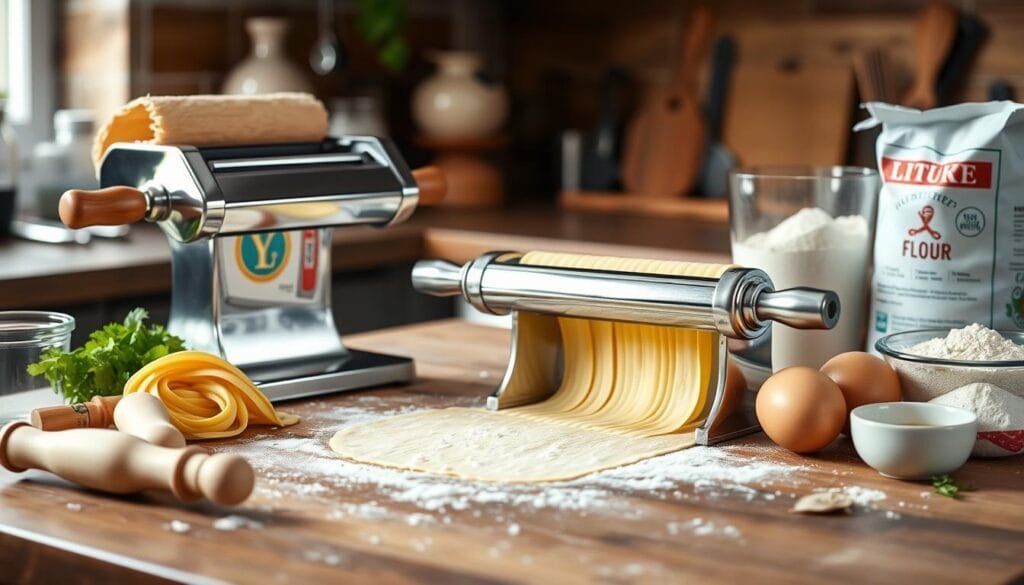
With the right tools and a bit of practice, you’ll soon be making delicious homemade pasta machine vegan gluten-free pasta.
Step-by-Step Pasta Making Process
Making vegan gluten-free pasta from scratch is rewarding. It lets you choose what goes into it and how it feels. You’ll mix, knead, and shape the dough into your favorite pasta forms.
Mixing the Dough
Start by getting your ingredients: 1 cup ’00’ pasta flour or white flour, 1 cup semolina flour, 1/2 cup water, 1.5 tablespoons olive oil, and 1/2 teaspoon salt. In a big bowl, mix the dry stuff and make a well. Slowly add the wet ingredients, then mix with a fork until it’s shaggy.
Kneading Techniques
When the dough comes together, put it on a floured surface. Knead for 5-10 minutes until it’s smooth and elastic. This makes the pasta strong but flexible. If it’s too dry, add a bit of water. If it’s too sticky, add flour.
Rolling and Shaping
After kneading, cover the dough and rest for 30 minutes. This makes the dough easier to roll. Then, roll it out thinly with a rolling pin or pasta machine, dusting with flour to prevent sticking. Cut it into your favorite shapes, like noodles, ribbons, or discs.
Follow these steps to make delicious vegan gluten-free pasta. It’s a fun way to make a versatile ingredient from scratch!
Making Pasta Without a Pasta Machine
Don’t worry if you don’t have a pasta machine. You can make your own fresh pasta by hand. This traditional method takes more effort but is worth it. Roll the dough thin with a rolling pin, then fold and slice it into shapes.
First, make your pasta dough. Let it rest, then flour a clean surface. Split the dough into four parts. Roll each part thin, about 1/8 inch, using a rolling pin. Keep everything floured to avoid sticking.
- Lightly flour the work surface and rolling pin.
- Divide the dough into four equal pieces.
- Roll each piece into a thin, even sheet about 1/8 inch thick.
- Fold the dough sheet in half, then in half again to create layers.
- Use a sharp knife to slice the folded dough into your desired pasta shapes, such as fettuccine or linguine.
- Gently unfold the pasta and place it on a lightly floured surface to dry before cooking.
This method takes practice but is rewarding. Hand-cut pasta has a unique texture and taste. You’ll feel proud of making it from scratch. Try it and enjoy your homemade pasta!
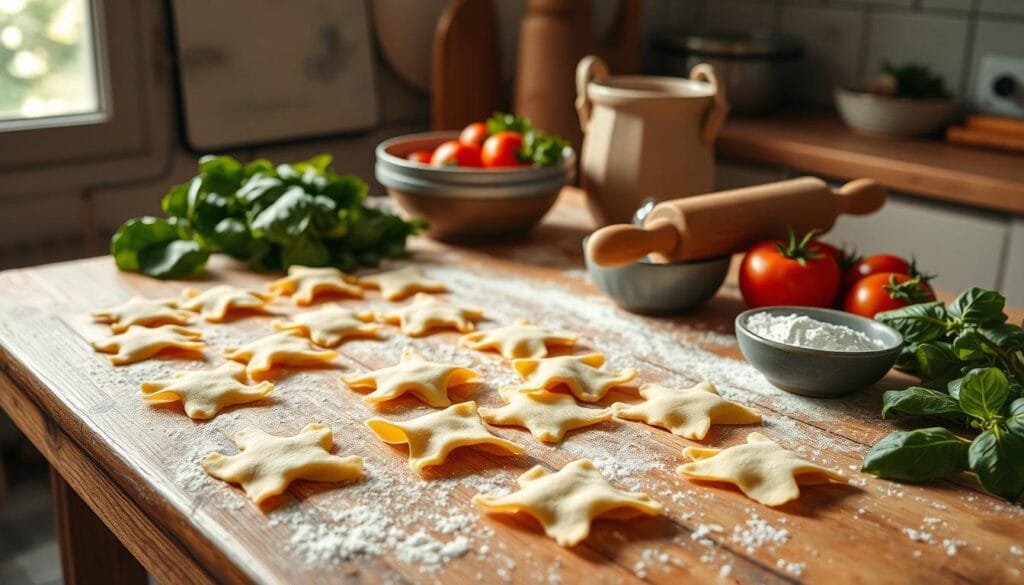
| Stat | Value |
|---|---|
| Recommended Serving Size | 2 ounces of fresh pasta per person |
| Uncooked Pasta Shelf Life (Fridge) | Up to 3 days |
| Frozen Pasta Shelf Life | Up to 8 weeks |
| Pasta Dough Resting Time | 30 minutes to 4 hours |
| Cooking Time for Homemade Pasta | Approximately 2 minutes, until tender |
By making your own hand-rolled pasta, you can enjoy authentic flavors. This simple method lets you make delicious noodles at home. No need for a special no-machine pasta maker.
Tips for Perfect Texture and Consistency
Getting the right pasta texture and consistency is essential for a great vegan gluten-free pasta dish. A few simple tips can help. Your pasta will have the perfect al dente bite and a smooth, silky feel.
Common Mistakes to Avoid
One big mistake in making gluten-free pasta is not enough flour. Make sure to flour your work surface and rolling pin well to avoid sticking. Don’t overwork the dough, as it can become tough and chewy. Aim for 5-7 minutes of kneading.
Also, watch the cooking time closely. Pasta that’s not cooked enough will be gummy. Overcooking makes it mushy.
Troubleshooting Guide
- If your pasta dough is too sticky, add a bit more flour until it’s right.
- For dough that’s too tough, add a tablespoon or two of water and knead gently to rehydrate it.
- When cooking gluten-free pasta, use a lot of flour to prevent sticking. Cook for 3-5 minutes until it floats to the top for the perfect al dente.
By following these pasta texture tips and avoiding common pasta making mistakes, you’ll make pasta with the perfect consistency every time.
Best Flour Options for Gluten-Free Pasta
Making gluten-free pasta at home means trying out different flours. These flours can make your pasta taste and feel like the real thing. Whether you’re vegan or gluten-free, there are great options to make your pasta-making journey better.
Gluten-Free 1:1 Baking Flour: Bob’s Red Mill and King Arthur have amazing gluten-free 1:1 baking flours. They can replace wheat flour in your pasta recipes. These mixes have gluten-free flours, starches, and stabilizers for a smooth dough and perfect texture.
Einkorn flour is another great choice for gluten-free pasta. It’s an ancient grain with less gluten. You might need to adjust the liquid in your recipe, but it makes pasta that’s tender and tasty.
- Bob’s Red Mill Gluten Free 1 to 1 Baking Flour
- King Arthur Measure for Measure Flour
- Bob’s Red Mill Gluten Free All-Purpose Baking Flour
- Krusteaz Gluten Free All-Purpose Flour
- Cup4Cup Gluten-Free Flour
Try different gluten-free flour blends to find the one you like best. With a bit of experimenting, you’ll find the flour that’s just right for you.
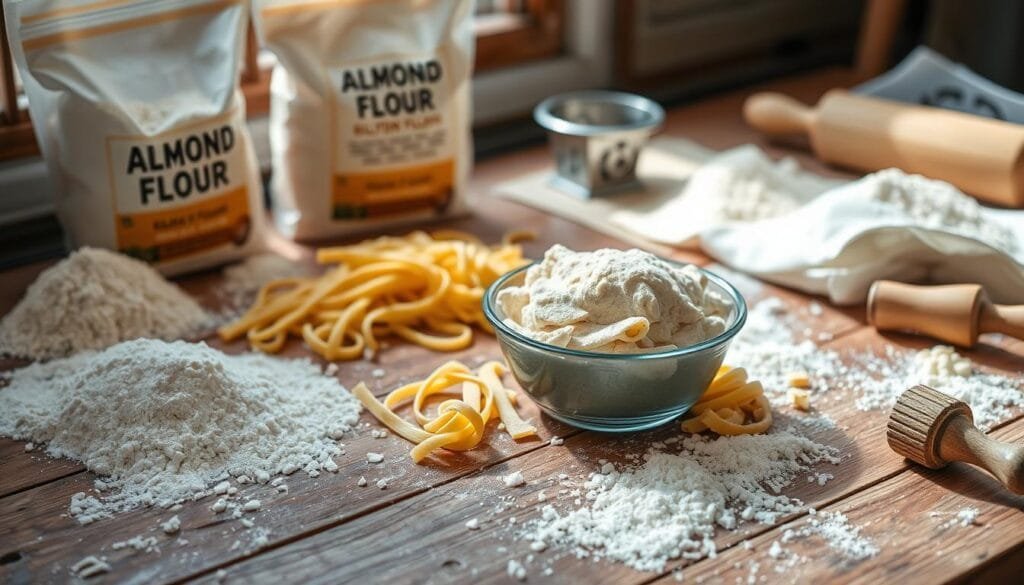
“The first gluten-free flour that can be substituted 1:1 for both all-purpose and wheat flour in any recipe is Cup4Cup flour, created by chefs at a renowned restaurant to allow gluten-free guests to enjoy gluten-free meals.”
Storage and Freezing Instructions
Storing your vegan and gluten-free pasta is easy. You can keep it in the fridge for up to 2 days after cooking. For longer storage, freezing is a great option. Just shape the dough into nests, wrap them in plastic, and put them in airtight bags or containers.
Frozen pasta stays good for up to 3 months. The best part? You don’t need to thaw it before cooking. Just drop it into boiling water and cook for a minute or two longer. This makes cooking a quick and easy process, perfect for busy nights.
Whether you store it in the fridge or freeze it, these tips will help you enjoy your pasta. You can always have a healthy pasta option ready, meeting your dietary needs without losing flavor or convenience.
